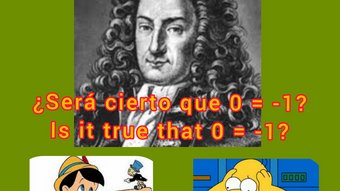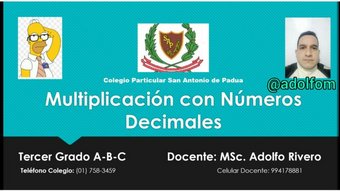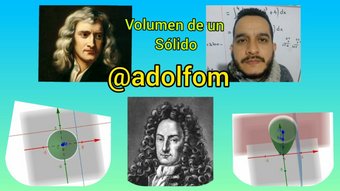(6÷2(2+1)=9 o 6÷2(2+1)=1? ¿Cuál es la respuesta correcta? Which is the right answer?
158
About :
Un cordial saludo a toda la comunidad.
En este video le damos respuesta a un problema que ha generado y sigue generando polémica desde hace un largo tiempo.
6÷2(2+1)=9 o
6÷2(2+1)=1
¿Cuál es la respuesta correcta?
Es un problema que se presta a confusión por no tener claro las jerarquías de las operaciones aritméticas, es decir:
Hay que resolver las operaciones en base a un orden , que se da a través de algunas reglas de juego que deben de respetarse, pero en dónde actualmente no hay un acuerdo claro entre todas las personas que las usan.
Las reglas para resolver operaciones Aritméticas combinadas comienzan de la siguiente manera:
Se resuelven todas las operaciones que están dentro de los signos de agrupación, en este caso pueden ser paréntesis, corchetes o llaves, pero si hay signos de agrupación dentro de otros signos como por ejemplo, los paréntesis dentro de los corchetes, y corchetes dentro de las llaves, procedemos a resolver de adentro hacia afuera.
Resolvemos las potencias y raíces.
Se resuelven las multiplicaciones y divisiones, tomando en cuenta que tienen la misma jerarquía, y si hay Operaciones combinadas de multiplicación y división, se procede a resolver de izquierda a derecha.
Por último se resuelven las sumas y restas, en caso de que hayan operaciones combinadas de adición y sustracción, se resuelve de izquierda a derecha.
Se usan algunos acrónimos, como los siguientes para poder recordarlos facilmente:
papomudas por «paréntesis, potencias, multiplicación, división, adición, sustracción» y
papomudisure por «paréntesis, potencias, multiplicación, división, suma, resta».
La multiplicación y división se resuelven de izquierda a derecha y tienen la misma
jerarquía.
La adición y la sustracción también se resuelven de izquierda a derecha y tienen la misma jerarquía.
Puedes verificar la información en este enlace
https://www.bbc.com/mundo/noticias-49168226
La asociación matemática de América en conjunto con Taylor & Francis Group publicó por primera vez en febrero de 1917 un artículo sobre el orden y la jerarquía de las operaciones aritméticas por el autor N. J. Lennes.
Puedes verificar la información en este enlace
http://www.jstor.com/stable/2972726
Todas las imágenes fueron descargadas de internet con Google.
Los efectos de transición del vídeo fueron hechos con powerpoint.
La música instrumental de fondo fue descargada de Youtube a través del siguiente enlace
Kind regards to the entire community.
In this video we give you an answer to a problem that has generated and continues to generate controversy for a long time.
6 ÷ 2 (2 + 1) = 9 or
6 ÷ 2 (2 + 1) = 1
Which is the right answer?
It is a problem that is confusing because the hierarchies of arithmetic operations are not clear, that is:
Operations must be solved based on an order, which occurs through some game rules that must be respected, but where currently there is no clear agreement among all the people who use them.
The rules for solving combined arithmetic operations will start as follows:
All the operations that are inside the grouping signs are solved, in this case they can be parentheses, brackets or braces, but if there are grouping signs inside other signs, for example, the brackets inside the brackets, and brackets Inside the keys, we proceed to solve from the inside out.
We solve the powers and roots.
Multiplications and divisions are solved, taking into account that they have the same hierarchy, and if there are combined operations of multiplication and division, a solver is carried out from left to right.
Finally the addition and subtraction are solved, in case there are combined operations of additional and subtraction, it is solved from left to right.
Some acronyms, such as the following, are used for easy recall:
papomudas by "parentheses, powers, multiplication, division, additional, subtraction" and
papomudisure by "parentheses, powers, multiplication, division, addition, subtraction".
Multiplication and division are solved from left to right and have the same
hierarchy.
Adding and subtracting are also solved from left to right and have the same hierarchy.
You can verify the information in this link
https://www.bbc.com/mundo/noticias-49168226
The American Mathematical Association in conjunction with Taylor & Francis Group first published an article on the order and hierarchy of arithmetic operations in February 1917 by author N. J. Lennes.
You can verify the information in this link
http://www.jstor.com/stable/2972726
All images were downloaded from the internet with Google.
The effects of the video transition were done with powerpoint.
The instrumental music in the background was downloaded from YouTube through the following link
Tags :
Their limit for today is $0!





























Comments:
Reply:
To comment on this video please connect a HIVE account to your profile: Connect HIVE Account